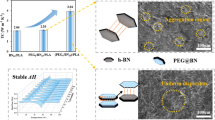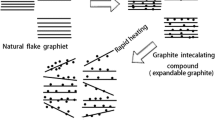Abstract
Thermally conductive polymer-based composites have drawn significant interest in the field of heat management. Herein, taking polylactic acid/alumina (PLA/Al2O3) composite as the research system, we investigated the influences of the content of Al2O3 and the crystallinity of PLA on the thermal conductivity of PLA/Al2O3 composite, and discussed the synergistic effect between the matrix crystallinity and the filler content and the corresponding thermal conduction mechanism. Results show that Al2O3 plays a heterogeneous nucleation role in crystallization of PLA, which significantly accelerates the crystallization rate and improves the crystallinity of PLA. Both crystallinity of PLA matrix and Al2O3 content contribute to the final thermal conductivity of the composite. When the filler content is lower than 50 wt%, the improvement of thermal conductivity for composite is mainly determined by Al2O3 content, and contribution from the crystallinity of PLA is very limited. When the Al2O3 content is higher than 60 wt%, which is sufficient to format a heat conduction network in the matrix, the high crystallinity of PLA combined with high filler content brings a synergistic effect and significantly enhances the final thermal conductivity of the composite. For composite of PLA containing 70 wt% Al2O3, when the crystallinity of PLA matrix increases from 4.63 to 59.8%, the corresponding thermal conductivity of the PLA/Al2O3 composite enhanced by 26.8% from 0.82 to 1.04 W m−1 K−1, which is more than 5 times higher than that of neat PLA. Such a remarkable improvement in thermal conductivity only by changing matrix structure without further adding fillers is of great significance for polymer-based thermally conductive composites.








Similar content being viewed by others
References
S.N. Leung, Thermally conductive polymer composites and nanocomposites: processing-structure-property relationships. Compos. B 150, 78–92 (2018)
A. Ma, J. Gu, W. Chen, Thermal conductivity polypropylene/aluminium nitride composites. Adv. Mater. Res. 194, 1577–1580 (2011)
R. Bao, S. Yan, R. Wang et al., Experimental and theoretical studies on the adjustable thermal properties of epoxy composites with silver-plated short fiberglass. J. Appl. Polym. Sci. 134, 45555–45561 (2017)
N. Bagotia, V. Choudhary, D.K. Sharma, Studies on toughened polycarbonate /multiwalled carbon nanotubes nanocomposites. Compos. B 124, 101–110 (2017)
K. Zhang, G.D. Xiao, Z. Zeng et al., A novel thermally conductive transparent die attach adhesive for high performance LED. Mater. Lett. 235, 216–219 (2019)
H.N. Guo, B.Y. Wen, Progress on research and application for filled thermal conductive polymeric composites. Eng. Plast. Appl. 42, 106–110 (2014)
X.L. Zheng, B.Y. Wen, Practical PBT/PC/GNP composites with anisotropic thermal conductivity. RSC Adv. 9, 36316–36323 (2019)
J. Gu, J. Du, J. Dang et al., Thermal conductivities, mechanical and thermal properties of graphite nanoplatelets/polyphenylene sulfide composites. RSC Adv. 4, 22101–22105 (2014)
S. Yang, W. Li, S. Bai et al., Fabrication of morphologically controlled composites with high thermal conductivity and dielectric performance from aluminum nanoflake and recycled plastic package. ACS Appl. Mater. Interface 11, 3388–3399 (2018)
F. Wang, X. Cai, Improvement of mechanical properties and thermal conductivity of carbon fiber laminated composites through depositing graphene nanoplatelets on fibers. J. Mater. Sci. 54, 3847–3862 (2018)
V.V. Vysotsky, V.I. Roldughin, Aggregate structure and percolation properties of metal-filled polymer films. Colloid Surf. A 160, 171–180 (1999)
Y. Hu, G. Du, N. Chen, A novel approach for Al2O3/epoxy composites with high strength and thermal conductivity. Compos. Sci. Technol. 124, 36–43 (2016)
S.G. Mosanenzadeh, S. Khalid, Y. Cui et al., High thermally conductive PLA based composites with tailored hybrid network of hexagonal boron nitride and graphene Nano platelets. Polym. Compos. 37, 2196–2205 (2016)
J. Che, M. Jing, D. Liu, K. Wang, Q. Fu, Largely enhanced thermal conductivity of HDPE/boron nitride/carbon nanotubes ternary composites via filler network-network synergy and orientation. Compos. A 112, 32–39 (2018)
L.B. Ma, B.Y. Wen, Y.H. Zhang, Research on polypropylene based thermally conductive composites filled with GNP and Al2O3. Eng. Plast. Appl. 46, 10–16 (2018)
W.Q. Zou, B.Y. Wen, Y. Zhang, Effects of transesterification on thermal conductivity of PBT/PC/Al2O3 composites. Acta Polym. Sin. 5, 606–613 (2016)
S. Deng, J. Wang, G. Zong et al., Effect of chain structure on the thermal conductivity of expanded graphite/polymer composites. RSC Adv. 6, 10185–10191 (2016)
S.H. Su, Y. Huang, S. Qu et al., Microdiamond/PLA composites with enhanced thermal conductivity through improving filler/matrix interface compatibility. Diamond Relat. Mater. 81, 161–167 (2018)
C. Fu, Q. Li, J. Lu et al., Improving thermal conductivity of polymer composites by reducing interfacial thermal resistance between boron nitride nanotubes. Compos. Sci. Technol. 165, 322–330 (2018)
M. Cao, J. Shu, P. Chen et al., Orientation of boron nitride nanosheets in CM/EPDM Co-continuous blends and their thermal conductive properties. Polym. Test 69, 208–213 (2018)
C. Pan, J. Zhang, K. Kou et al., Investigation of the through-plane thermal conductivity of polymer composites with in-plane oriented hexagonal boron nitride. Int. J. Heat Mass Transfer 120, 1–8 (2018)
H. Wang, D. Ding, Q. Liu et al., Highly anisotropic thermally conductive polyimide composites via the alignment of boron nitride platelets. Compos. B 158, 311–318 (2019)
Y. Ouyang, G. Hou, L. Bai et al., Constructing continuous networks by branched alumina for enhanced thermal conductivity of polymer composites. Compos Sci Technol 165, 307–313 (2018)
B.Y. Wen, X.L. Zheng, Effect of the selective distribution of graphite nanoplatelets on the electrical and thermal conductivities of a polybutylene terephthalate/polycarbonate blend. Compos. Sci. Technol. 174, 68–75 (2019)
J. Yu, B. Sundqvist, B. Tonpheng et al., Thermal conductivity of highly crystallized polyethylene. Polymer 55, 195–200 (2014)
L. Bai, X. Zhao, R.Y. Bao et al., Effect of temperature, crystallinity and molecular chain orientation on the thermal conductivity of polymers: a case study of PLLA. J. Mater. Sci. 53, 10543–10553 (2018)
R.-C. Zhang, Z. Huang, D. Sun et al., New insights into thermal conductivity of uniaxially stretched high density polyethylene films. Polymer 154, 42–47 (2018)
T. Zhao, X. Zhang, Enhanced thermal conductivity of PE/BN composites through controlling crystallization behavior of PE matrix. Polym. Compos. 38, 2806–2813 (2015)
D.M. Bigg, Metal-Flled Polymers (Marcel Dekker, New York, 1986)
W.Q. Zou, B.Y. Wen, Influence factors of the thermal conductivity for a filled thermal conductive polymeric composite. Polym. Mater. Sci. Eng. 31, 178–183 (2015)
Y. Agari, T. Uno, Estimation on thermal conductivities of filled polymers. J. Appl. Polym. Sci. 32, 5705–5712 (1986)
P. Zhang, P. Yuan, X. Jiang et al., A theoretical review on interfacial thermal transport at the nanoscale. Small 14, 1702769–1702787 (2018)
W.Y. Zhou, X.W. Ding, Thermal conductive polymer materials (National Defense Industry Press, Beijing, 2014)
T.B. Lewis, L.E. Nielsen, Dynamic mechanical properties of particulate-filled composites. J. Appl. Polym. Sci. 14, 1449–1471 (1970)
M.X. Li, P.B. Liu, P. Fan et al., Effects of alumina on crystallization and thermal conductivity properties of polyethylene. China Plast. 23, 49–52 (2009)
A. Bakour, M. Baitoul, E. Faulques et al., Thermal stability and structural study of the poly (3-hexyl thiophene)/HiPCO single walled carbon nanotubes (P3HT/SWCNT) nanocomposites. Eur. Phys. J. 74, 24609 (2016)
Acknowledgements
The authors wish to thank the Project of Innovative research team of new functional materials of Beijing Technology and Business University for the financial support to this research.
Author information
Authors and Affiliations
Corresponding author
Additional information
Publisher's Note
Springer Nature remains neutral with regard to jurisdictional claims in published maps and institutional affiliations.
Rights and permissions
About this article
Cite this article
Wen, B., Ma, L., Zou, W. et al. Enhanced thermal conductivity of poly(lactic acid)/alumina composite by synergistic effect of tuning crystallization of poly(lactic acid) crystallization and filler content. J Mater Sci: Mater Electron 31, 6328–6338 (2020). https://doi.org/10.1007/s10854-020-03189-x
Received:
Accepted:
Published:
Issue Date:
DOI: https://doi.org/10.1007/s10854-020-03189-x




